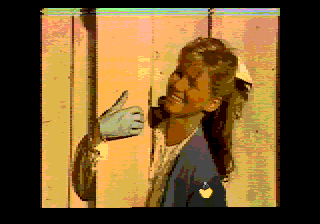I have amassed quite a collection of Sega CD titles over my years of multimedia hacking. Since it was an early CD-based console, I reasoned that at least some of the games would contain full motion video (FMV). In fact, essentially all Sega CD games fall into one of the following 2 categories:
- Standard 16-bit Sega Genesis-type games that were enhanced by a Red Book CD audio soundtrack
- Games that were driven entirely by very low-quality FMV

Screenshot of Mad Dog McCree for the Sega CD, an FMV-driven FPS
Many Sega CD games, particularly those published by Sega itself, contain many large files with the extension .sga. I have never made much headway on understanding any of these files, save for the fact that many of them use sign/magnitude 8-bit PCM audio. As for the video codec, “Cinepak” or “Cinepak for Sega” is often thrown around. I can certify that it is not the stock Cinepak data commonly seen in the early FMV era. Though perhaps the Sega CD console was the proving ground for later Cinepak technologies. A lot of Sega CD FAQs around the internet were apparently plagiarized from each other, which must have originally been plagiarized from Sega marketing material because they all shallowly list one of the system’s graphical capabilities as “Advanced compression scheme.”